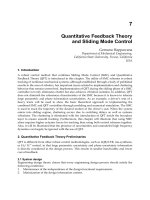Evaporation Condensation and Heat transfer Part 6 pot
Bạn đang xem bản rút gọn của tài liệu. Xem và tải ngay bản đầy đủ của tài liệu tại đây (2.51 MB, 40 trang )
Evaporation, Condensation and Heat Transfer
190
Modelling the Thermo-Hydraulic Performance of
Cooling Networks and Its Implications on Design, Operation and Retrofit
191
Δ
∆
π
⎛⎞
⎜⎟
⎝⎠
Δ ρ
⎛⎞
⎜⎟
⎝⎠
Δ ρ
π
⎛⎞
⎛⎞
⎜⎟
⎜⎟
⎝⎠
⎝⎠
ρ
π
⎛⎞
⎛⎞
⎜⎟
⎜⎟
⎝⎠
⎝⎠
Evaporation, Condensation and Heat Transfer
192
Δ
Δ
Δ
Δ
Δ
Δ Δ
A
B
A
B
Modelling the Thermo-Hydraulic Performance of
Cooling Networks and Its Implications on Design, Operation and Retrofit
193
Δ
⎛⎞
⎜⎟
⎜⎟
⎝⎠
ε
ε
ε
()
()
()
ε
⎧
⎫
⎡
⎤
⎛⎞
⎪
⎪
⎢
⎥
⎜⎟
⎜⎟
⎪
⎪
⎢
⎥
⎝⎠
⎨
⎬
⎢
⎥
⎛⎞
⎪
⎪
⎢
⎥
⎜⎟
⎪
⎪
⎜⎟
⎢
⎥
⎝⎠
⎣
⎦
⎩⎭
Evaporation, Condensation and Heat Transfer
194
Type of fitting or valve
Loss coefficient
(K)
Type of fitting or valve
Loss coefficient
(K)
θ
θ
Modelling the Thermo-Hydraulic Performance of
Cooling Networks and Its Implications on Design, Operation and Retrofit
195
()
ε
()
ε
T
H
T
1
T
2
t
1
t
2
T
1
t
2
T
2
t
1
T
H
T
1
T
2
t
1
t
2
T
1
t
2
T
2
t
1
Evaporation, Condensation and Heat Transfer
196
C1
C3
C4
H1
H2
H3
H4
Cooling
water
C5
H5
C2
t
1
t
2
t
3
t
4
t
5
t
6
t
7
T
1
T
2
T
3
T
4
T
5
T
6
T
7
T
8
T
9
T
10
V
1
V
2
V
3
V
4
V
T
C1
C3
C4
H1
H2
H3
H4
Cooling
water
C5
H5
C2
t
1
t
2
t
3
t
4
t
5
t
6
t
7
T
1
T
2
T
3
T
4
T
5
T
6
T
7
T
8
T
9
T
10
V
1
V
2
V
3
V
4
V
T
⎛⎞
⎜⎟
⎜⎟
⎝⎠
∑
Modelling the Thermo-Hydraulic Performance of
Cooling Networks and Its Implications on Design, Operation and Retrofit
197
Evaporation, Condensation and Heat Transfer
198
From heat balance
determine V; estimate a
value for K
Determine ΔP
Fix exchanger geometry:
length, shell diameter,tube diameter,
tube pitch, tube arrangement.
Determine No. tubes
Calculate ΔP
calc
ΔPcalc - ΔP ≤ error
Yes
Final design
New shell diameter
and No. of tubes
Calculate overall heat transfer
Coefficients and ΔTlm
From heat balance
determine V; estimate a
value for K
Determine ΔP
Fix exchanger geometry:
length, shell diameter,tube diameter,
tube pitch, tube arrangement.
Determine No. tubes
Calculate ΔP
calc
ΔPcalc - ΔP ≤ error
Yes
Final design
New shell diameter
and No. of tubes
Calculate overall heat transfer
Coefficients and ΔTlm
Modelling the Thermo-Hydraulic Performance of
Cooling Networks and Its Implications on Design, Operation and Retrofit
199
For every exchanger specify: t’s, T’s,
V’s, ΔP
allowable
, Q, F
T
For the network specify: valve’s, d
pipe’s
, pump
capacity, N
p
, L
t
, d
i
, d
o
Calculate K for valves and pipes
Assume number of tubes (Nta) and
calculate K for heat exchangers
Calculate ΣK
pipe, valve, Cx
for each single branch
Calculate K for network
arrangement and K
overall-system
Calculate ΔP
system
Calculate flow distribution
Specify K
Cx’s-req
= f(ΔP
C
x
allow
, F
hx
) and compare with K
Cx
Calculate t
out’s
= f(Q
Cx-req
, t
in
, V
C
x
)
Calculate temperature correction
factor
Calculate h
t
, h
s
and U
overall
Calculate LMTD’s
Calculate heat transfer
area, A
Cx’s
Calculate number of tubes, Nt
End
Modify
number of
tubes
Nt = Nta
For every exchanger specify: t’s, T’s,
V’s, ΔP
allowable
, Q, F
T
For the network specify: valve’s, d
pipe’s
, pump
capacity, N
p
, L
t
, d
i
, d
o
Calculate K for valves and pipes
Assume number of tubes (Nta) and
calculate K for heat exchangers
Calculate ΣK
pipe, valve, Cx
for each single branch
Calculate K for network
arrangement and K
overall-system
Calculate ΔP
system
Calculate flow distribution
Specify K
Cx’s-req
= f(ΔP
C
x
allow
, F
hx
) and compare with K
Cx
Calculate t
out’s
= f(Q
Cx-req
, t
in
, V
C
x
)
Calculate temperature correction
factor
Calculate h
t
, h
s
and U
overall
Calculate LMTD’s
Calculate heat transfer
area, A
Cx’s
Calculate number of tubes, Nt
End
Modify
number of
tubes
Nt = Nta
Evaporation, Condensation and Heat Transfer
200
Δ
Modelling the Thermo-Hydraulic Performance of
Cooling Networks and Its Implications on Design, Operation and Retrofit
201
Δ
Evaporation, Condensation and Heat Transfer
202
,
Modelling the Thermo-Hydraulic Performance of
Cooling Networks and Its Implications on Design, Operation and Retrofit
203
Evaporation, Condensation and Heat Transfer
204
Modelling the Thermo-Hydraulic Performance of
Cooling Networks and Its Implications on Design, Operation and Retrofit
205
ε
Δ
ρ
Evaporation, Condensation and Heat Transfer
206
10
Heat Exchange in Furnace Side Walls with
Embedded Water Cooled Cooling Devices
Gabriel Plascencia
CIITEC –IPN México, D.F.,
México
1. Introduction
Current copper (as well as nickel and lead) smelting and converting are characterized by
high intensity and productivity. However, this has lead to increasing demands on
refractories resulting in possible shortening of the service life of furnace linings. To
counteract this, several cooling systems have been designed and implemented in many
copper and / or nickel making facilities (Hatch & Wasmund, 1974; Legget & Gray, 1996).
The different cooling systems can be grouped according to their ability to remove heat from
the hearth of the furnace as shown in Table 1. Cooling systems that are embedded into the
furnace refractory lining are able to extract more energy (10 ~ 100 kW/m
2
) than those acting
on the furnace outer shell (~ 1 kW/m
2
); this main difference is due to the thermal resistance
that the insulating refractory lining offers (Legget & Gray, 1996).
System Location
Heat Flux
(kW/m
2
)
Applications Pros Cons
Plate
coolers
Internal 10 – 30
Stack region of iron
blast furnaces /
flash smelters
High intensity
cooling,
supports lining
Water leaks,
limited by
structural
considerations
Staves Internal 20 – 30
Stack region of iron
blast furnaces
Applicable in
thin wall
sections
Limited control,
expensive
Internal
jackets
Internal 10 – 30
Flash and electric
furnaces
Cheaper than
plates
Water leaks,
uneven cooling
Panels Internal > 30
Electric furnaces,
Vanyukov bath
smelting, Zn
fuming
No refractory
needed, high heat
fluxes
Water leaks,
develop
mechanical stresses
External
jackets
External 5 – 15
Temporary cooling
for overheated
walls
No need to shut
down
Limited heat flux
in thick sections
Spray
cooling
External 5 – 15
Electric and flash
furnace reaction
shaft
Cheap, no need to
shut down
Corrosion in the
outer shell, limited
heat flux
Air
cooling
External < 10
Underneath of
many furnaces
Cheap,
water free
Very low heat
fluxes
Table 1. Cooling systems industrially available, after Legget and Gray (Legget & Gray, 1996)
Evaporation, Condensation and Heat Transfer
208
Another factor that affects the difference in the heat flux removal is that the systems that are
embedded in the refractory are closer to the furnace’s hot face, reducing the effective heat
transfer distance, thus increasing the ability to remove heat.
Proper cooling system design is necessary since not every smelter runs in the exactly same
manner, as an example, if the side wall heat flux is too low, the refractory may wear back, or
if the cooling is highly intense, the excessive cooling may lead to higher heat losses.
Modern smelting processes such as flash, bath or electric furnace, make external cooling
unsuitable for their implementation, instead embedded systems are required due to their
capacity to extract more heat and thus protect the refractory walls.
Hatch and Wasmund (Hatch & Wasmund, 1974) recognized that refractories are attacked by
several mechanisms, such as melting, dissolution by molten metal/slag, chemical reactions
between the refractory and the slag. They also acknowledged that refractory spalling may
happen as a result of thermal cycling and also tapping and charging operations may
promote refractory erosion due to the collision of the charging materials with the lining.
Another problem related to the lining wear is the penetration of molten material into cracks
or joints. Thermal cycling not only induces stresses into the lining they also promote the
freezing and re-melting of the material deposited on the cracks, enlarging them to a point
where leaking of the molten material may produce run outs.
The major operational problems associated with embedded cooling systems are:
• Water leaking through the refractory lining, which in the worst case scenario may result
in catastrophic explosions due to the contact of cooling water with the molten metal. It
also may happen that the leaked water reacts with the process gas (especially SO
2
),
resulting in corrosion of the cooling devices, reducing their ability to extract heat.
• Uneven control of the wall heat transfer resulting in either increased refractory wear or
heat losses
• Air gaps formed as a result of the thermal cycles experienced by the furnace or due to
manufacturing problems of the cooling devices, causing loss of the cooling efficiency.
(a)
(b)
Fig. 1. Hot end of water cooled copper finger after being removed from a flash furnace. (a)
Front view, (b) lateral view. The dotted lines represent the original dimensions of the cooler.
Merry et al (Merry et al., 2000) offer similar data on the amount of heat that can be removed
with different cooling systems. Notice that in this compilation Merry et al, include finger
coolers. These cooling devices are in the mid range in terms of heat removal, they account
Heat Exchange in Furnace Side Walls with Embedded Water Cooled Cooling Devices
209
for a heat flux capacity of nearly 100 kW/m
2
, which accordingly to Legget and Gray (Legget
& Gray, 1996) is equivalent to the energy that can be removed using panel coolers.
Furnace sidewall heat flux
(
W/m
2
)
10
1
10
2
10
3
10
4
10
5
10
6
10
7
Natural air cooling
Forced air coolers
Finger coolers
Plate coolers
Waffle coolers
Fig. 2. Furnace side wall heat flux (W/m
2
), after Merry et al (Merry et al 2000).
To estimate the actual heat removal capacity of the cooling systems, in this text it is
presented the results from some experimental work on laboratory scale finger coolers. These
results are then compared with 3-D heat transfer finite element modelling of a real size
cooling system. Comparison between experimental data and computations are in very good
agreement.
2. High temperature immersion tests
2.1 Materials
The cooling elements used in this work were made of pure copper, copper- 4% wt.
aluminium alloy, composite Cu / Cu - 4wt% Al alloy and nickel-plated copper. In each case,
high purity copper and aluminium were used. For nickel plating, analytic grade chemicals
were used. The design and dimensions of the cooling elements are shown in Figure 3;
whereas Figure 4 shows a scheme of the composite cooler.
The copper coolers were machined to the specified dimensions from copper bars. The
elements made of the Cu - 4% Al alloy were formed by pre-melting and alloying, before
casting and machining. The alloys were machined to the same dimensions as those of the
pure copper elements. The composite coolers were made by casting the Cu-4% Al alloy and
then machining them into bottom closed hollow cylinders with wall thickness of 3mm; once
machined, pure copper was poured into the alloy cylinders. The copper filled cylinders were
then machined to the same dimensions as the other cooling elements. The nickel plated
copper elements were prepared by plating nickel onto pure copper coolers previously
machined. The electrolyte consisted of nickel chloride (240 g/L) and hydrochloric acid (125
mL/L). Electrolysis was carried out between 25 and 29 ºC, with a cathode current density of
9 A/m
2
(Aniekwe & Utigard, 1999; Aniekwe, 2000).
Evaporation, Condensation and Heat Transfer
210
Fig. 3. Schematics of the cooling devices used in this work.
Fig. 4. Schematics of the composite cooling finger.
2.2 Procedures
To remove heat from molten matte or slag, the cooling fingers were screwed to a heat
removal device. This device was made of copper and it consisted of a water channel and an
opening for a thermocouple. To prevent oxidation of this device, it was covered with boron
nitride and fibre glass insulation cloth. Thermocouples were also inserted at the water inlet
and outlet respectively.
Thermocouples
(k - type)
Cooling
element
Water flow
Heat removal
device
Water channel
Fig. 5. Schematics of the heat removal device attached to a cooling finger
Heat Exchange in Furnace Side Walls with Embedded Water Cooled Cooling Devices
211
Immersion tests were carried out in an electric furnace. The cooling fingers were dipped into
pre-melted copper matte or slag, both provided by the Xtrata Technology Centre. The tests in
mattes were carried out at 1150 ºC, while the tests in slags were carried out at 1250 ºC. Every
test in the matte lasted 1.5 hrs, while those in the slag 2.5 hrs. After these times there was no
significant change in any of the temperatures, indicating that steady state had been reached.
The various temperatures were recorded continuously by a data acquisition system. Five k-
type thermocouples were used to register the temperature changes in the system. They were
located as follows: 1) in the melt, 2) inside the cooler, 3) at the cooler / melt interface (cooler
tip), 4) at the water inlet and 5) at the water outlet. Data began to be collected 10 minutes
before every immersion test in order to ensure uniform melt temperature. The water flow
rate was measured both at the inlet and outlet by means of two flow-meters, and controlled
by a third flow-meter with a larger scale.
3. Results and discussion
As mentioned, three different types of finger coolers were tested. The purpose was to
compare the thermal response and oxidation behaviour of bare copper and protected
copper. The copper was protected in two different ways: 1) Alloying it with aluminium and
2) depositing onto its surface a thick layer (~80 mm) of nickel.
Another important feature of these tests that must be emphasized is that they were
performed under extreme conditions. The cooling elements were immersed directly into the
molten matte and molten slag with no refractory protection. The reason for performing the
tests in this fashion was to evaluate the capacity of protected copper to extract heat from the
molten phase and then compare such capacity with that of the un-protected copper. In other
words, although the ultimate goal is to protect the refractory lining, in this research, the
ultimate goal is to evaluate the thermal and oxidation behaviour of the materials that may
be used to construct the cooling systems.
After every test, the cooling element was removed and cut for optical and microscopical
examination. Also, X-ray diffraction was carried out on tarnishing products that were
peeled off the cooler surface after the immersion test.
3.1 Immersion in a copper matte
The different cooling elements were tested in a Xtrata copper matte (68 wt% Cu) at 1150 ºC ±
10 ºC. Some of the cooling elements were pre-oxidized in air at 400 ºC for 72 hrs in order to
estimate the effect of an oxide layer on the cooling efficiency. Such tests are important
because it is expected that an oxide layer may form on the cooling devices after being
embedded within the refractory lining.
Figure 6 shows typical experimental curves. After approximately 11 minutes into the test,
the different temperatures did not change significantly, indicating that steady state was
reached. Once steady state was reached, it was possible to estimate the heat flux through
the cooling element. The heat flux (q/A) was calculated using the following equation:
WW W W
q
= ρ ×Q ×Cp ×ΔT
A
(1)
Where A is the area of the cooler that is actually immersed in the molten material (m
2
), ρ
W
is
the density of water (kg/m
3
), Q
W
is the volumetric flow of the cooling water (m
3
/s), Cp
W
is
Evaporation, Condensation and Heat Transfer
212
the heat capacity of water (J/kg/ºC) and ΔT
W
is the temperature difference between the
outlet and the inlet of the cooling water (ºC).
Fig. 6. Typical experimental curves obtained in cooling tests both for matte and slag.
The heat flux shown in Table 2 was estimated using the actual contact area between the
cooler and the melt; if only the cross sectional area of the cooler was considered (as it is
commonly reported (Hatch & Wasmund, 1974; Merry et al., 2000)), the heat flux through the
Time (min)
0 30 60 90 120 150 180
Temperature (°C)
0
10
20
30
600
800
1000
1200
Slag
Cooler/slag
Cooler centre
Water outlet
Water inlet
Immersion in slag
Time (min)
0 30 60 90 120
Temperature (°C)
0
10
20
30
40
800
1000
1200
Immersion in matte
Matte
Cooler/matte
Cooler centre
Water outlet
Water inlet
Heat Exchange in Furnace Side Walls with Embedded Water Cooled Cooling Devices
213
copper coolers would have been between 2 and 4 MW/m
2
. The table also shows that the
heat flux for the alloy coolers is about 60% lower than that of the copper coolers. Ni plated
coolers extract the same energy as the copper coolers.
The tests carried out with cooling fingers made of Cu - 4% Al alloy, registered a mass loss.
This mass loss was due to the dissolution of the finger into the matte. This dissolution
happens as a result of the inability of this material to extract sufficient heat from the molten
matte to promote solidification of a protective shell. However, direct comparison of the
actual heat flux extracted with the nominal heat flux for this type of cooling elements in
Figure 7.2, reveals that in spite of the dissolution and its poor heat extraction capacity, the
alloy cooler still was able to extract up to 5 times more heat from the matte than the
maximum recommended in literature (Merry et al., 2000).
On the other hand, the mass increase of coolers made of pure copper or nickel plated
copper, showed their ability to solidify matte on them. Table 2 also shows the cooling
water temperature change for the different tests carried out. From this table it is clear that
the temperature change is very similar for both the cooper coolers and the nickel-plated
copper coolers, whereas the temperature difference for the alloy coolers is about half of
the change registered for the other materials. This decrease of the temperature differential
corresponds well with the decrease in thermal conductivity of copper with aluminium
alloying. Values reported in the literature (K. Ho & Phelke, 1985; Touloukian & C.Y. Ho,
1970), indicate that the thermal conductivity of the Cu-4% Al alloy is only about 60% of
that of pure copper.
After every test, samples of the scales formed on the surface of the coolers during immersion
were sent for XRD analysis. Only the copper coolers developed a noticeable external scale,
whereas neither the nickel-plated coolers nor the alloy coolers did so. XRD showed that only
copper oxides (mainly Cu
2
O) were formed, no indication of any sulphide or sulphate or any
other possible reaction product was detected.
Cooler
Water
flow rate
(L/min)
Cooling water
temperature change
(ºC)
Mass
change (g)
Heat flux
(kW/m
2
)
Remarks
1.0 16 - 80 350 Not treated
1.5 13 - 63 427 Not treated
4 wt % Al
alloy
1.5 15 - 128 492 Pre-oxidized
1.0 26 198 569 Not treated
1.5 25 150 820 Not treated
Ni plated
cooler
1.5 24 165 788 Pre-oxidized
1.0 28 98 613 Not treated
1.5 27 158 886 Not treated
Bare
copper
1.5 28 59 919 Pre-oxidized
Table 2. Immersion tests in molten copper matte at 1150 ºC
Figure 7 shows the different materials after being immersed in the matte. In the case of the
copper cooler, some matte solidified on the bottom end of the cooler. It is also seen that
some oxides developed on the cooler surface. In the case of coolers made of the 4% Al alloy,
they dissolved after being immersed, with no indication of any solid crust.









